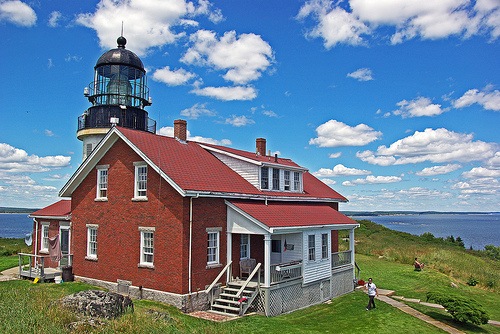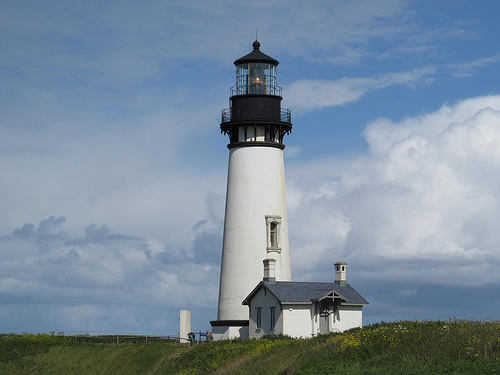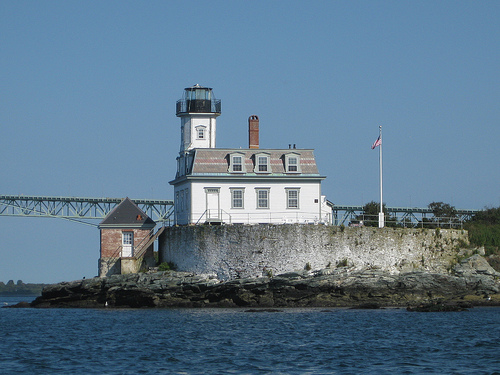While the lighthouse keepers of old are, for the most part, retired due to automation, the lighthouses themselves – and the lights, of course – remain working to keep mariners away from rocky cliffs, land, coral reefs, and other potentially dangerous areas that are hard to see in the dark, in storms, or in fog.
These days, many lighthouses have been turned into unique inns, but some offer lighthouse keeping programs. Lighthouse keeper duties range from relatively light (no pun intended) to full-time positions. The lighthouse volunteers are often responsible for greeting guests, providing a little about the history of the lighthouse, helping in the gift shop, clearing debris from the beach, etc.
Put a lighthouse stay on your travel list and learn what life was like for the lighthouse keepers of the past – the isolation, the quiet, the epic views, the powerful storms. The following are some of the most beautiful lighthouse stays you can put on your bucket list.
Battery Point Lighthouse – Crescent City, California

Originally named for three cannons salvaged from the wreckage of the ship America, which burned in the harbor of Crescent City in 1855, that were fired off on Fourth of July celebrations, Battery Point lighthouse is located on an exposed rocky mound and regularly battered by storms.
On March 27. 1962 the strongest earthquake ever recorded in the northern hemisphere – a magnitude 9.2, struck Alaska near Prince William Sound generating a series of waves that raced south at 600 MPH around midnight. The lighthouse keepers – and the lighthouse – survived the resulting tsunami but eleven others died.
Photo credit: Alan Vernon via flickr
Seguin Island Lighthouse – Sequin Island, Maine

One of the oldest lighthouses on the Atlantic coast and authorized by President George Washington, the current lighthouse is the second to be built on this site. Seguin Island is one of the foggiest places in the world – one year the fog signal blew for nearly one-third of the year.
Photo credit: foroyar22 via flickr
Yaquina Head Lighthouse – Yaquina Head, Oregon

The history of this lighthouse is troubled and colorful. In the 1920s there were three people working the lighthouse. One night, the head keeper went into town leaving his assistants behind. One got drunk and the other very ill (he soon died). After that, a ghost reportedly haunted the lighthouse.
Ships passing close to Yaquina Head regularly reported their compasses going awry, but the explanation was found in a vein of magnetized iron in the outcropping on which the lighthouse sits.
Browns Point Lighthouse – Point Brown, Washington

Situated on the eastern side of the entrance into Commencement Bay, which leads from Puget Sound to the port of Tacoma, Browns Point Lighthouse was originally built on land owned by an Indian of the Puyallup Indian Reservation before Washington was a state. Fog posed a significant problem for shipping in the area and during periods of dense fog, the keeper didn’t get much rest.
Photo credit: mjardeen via flickr
Bodie Island Lighthouse – Bodie Island, North Carolina

Originally named after the family who owned the island, folklore has it that the name resulted from the number of shipwrecked bodies that washed ashore. Rising 165 feet and painted in striking black and white stripes the current lighthouse is actually the third attempt to illuminate the perilous stretch of coast from Cape Hatteras to Currituck Beach, known as the Graveyard of the Atlantic. The first was abandoned due to a poor foundation, the second was destroyed by retreating Confederate troops, and the third was completed in 1872.
Photo credit: The Uprooted Photographer via flickr
Garden Key Lighthouse – Fort Jefferson, Florida (the Dry Tortugas)

Located near the center of the Dry Tortugas, a small cluster of reefs, islands, and shoals about 70 miles from Key West, the Garden Key lighthouse marks the spot where Ponce de Leon anchored in 1513. The current iron structure replaced the old lighthouse which was badly damaged in an October hurricane in 1873.
Photo credit: lighthouser via flickr
Pottawatomie Lighthouse – Rock Island, Wisconsin

The Rock Island Passage is the widest passage connecting Green Bay and Lake Michigan. The site of the lighthouse is atop a 137-foot bluff and the lighthouse itself became operational in 1837. In January 1876, the keeper reported two men attempting to row a boat to the mainland from a nearby island never arrived – a terrible storm came up shortly after their departure. They were later seen frozen stiff and sitting upright in the boat and adrift on a mass of ice.
Photo credit: eaghra via flickr
Rose Island Lighthouse – Rose Island, Rhode Island

Due to its strategic position at the entrance to Newport Harbor, the Rose Island lighthouse has been used by both British and colonial troops, overlooked a rifle practice range, used for storage by the U.S. Navy’s torpedo manufacturing unit, and more.
This lighthouse’s proximity to Newport means it’s not as isolated as many lighthouse stations, but lighthouse keepers still had to endure some pretty extreme weather. Storms have bent the tower to the point of breaking the plaster inside the house, torn the chimney down, and despite the light, boats still smashed on the island and sometimes into the lighthouse itself.
Photo credit: StJenna via flickr
Cape Blanco Lighthouse – Cape Blanco, Oregon

Built in 1870 and the oldest standing lighthouse on the Oregon coast, Cape Blanco is just one and a half miles off Oregon’s southern coast, the cape sports chalky white cliffs that prompted Spanish explorers to name the landmark Cape Blanco (or White Cape). There are no roads leading to the cape, and high winds buffet Cape Blanco through much of the year.
Photo credit: Dougtone via flickr
Loggerhead Key Lighthouse – Loggerhead Key, Florida (the Dry Tortugas)

During the Civil War, roughly two thousand people lived on Garden Key and the loggerhead turtles on Loggerhead Key were a primary source of food. A hurricane of 1873 inflicted heavy damage on the lighthouse but the tower was patched and inspected. The repairs were so effective a new tower was never built.
The lighthouse was automated in 1987 and volunteers stay in the original building that served as the kitchen and keeper’s dwelling. In 1992, the area was designated Dry Tortugas National Park and encompasses all seven islands of the Dry Tortugas as well as the surrounding coral reefs and shoals. The loggerhead turtles continue to return to the island to lay their eggs – now without fear of being eaten.
Photo credit: www.gregmillerbirding.com
What should you know about a lighthouse stay?
Some lighthouse keeping programs are offered at no charge and others include a fee, but the rates are far less than you’d pay to stay at a hotel. A typical lighthouse stay ranges from one week to four weeks. Advanced planning is required as some of the lighthouses have 2-year waiting lists for keeper stays!
Most of the lighthouse keeper’s quarters have modern appliances, so you’re no longer required to cook your dinner over a wood-fired stove.
Temporary and/or volunteer lighthouse keeper programs are a wonderful working vacation experience and it comes with the benefit of being able to stay in an actual lighthouse.
Resources
